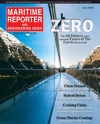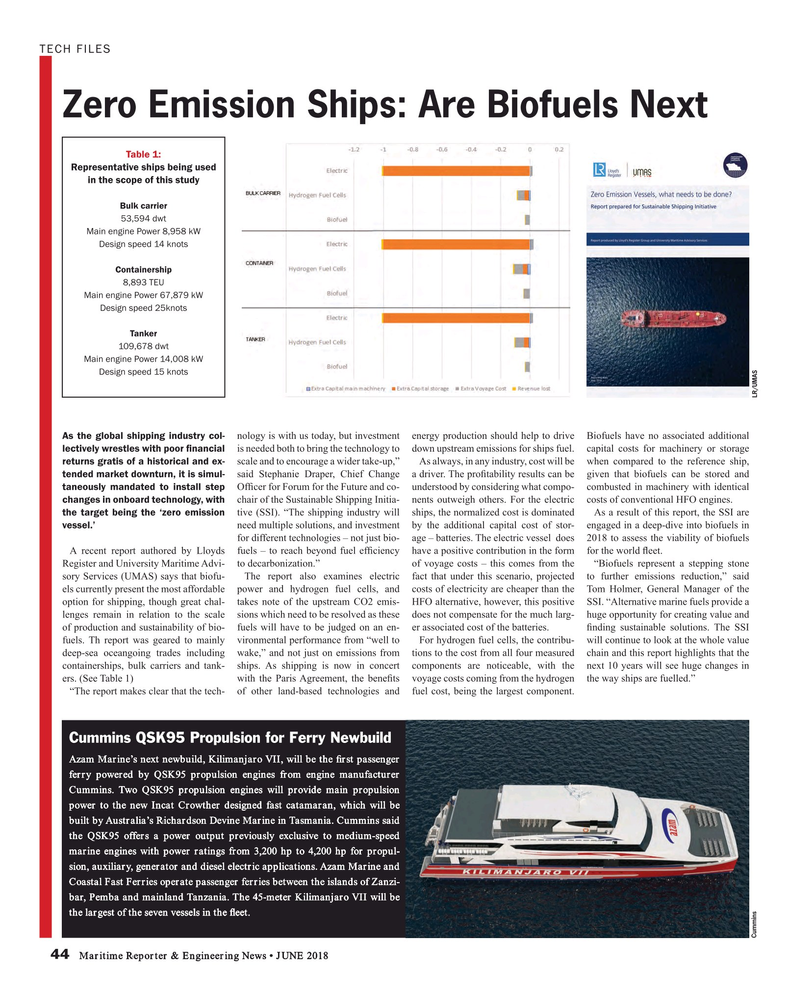
Page 44: of Maritime Reporter Magazine (June 2018)
Green Marine Technology
Read this page in Pdf, Flash or Html5 edition of June 2018 Maritime Reporter Magazine
TECH FILES
Zero Emission Ships: Are Biofuels Next
Table 1:
Representative ships being used in the scope of this study
Bulk carrier 53,594 dwt
Main engine Power 8,958 kW
Design speed 14 knots
Containership 8,893 TEU
Main engine Power 67,879 kW
Design speed 25knots
Tanker 109,678 dwt
Main engine Power 14,008 kW
Design speed 15 knots
LR/UMAS
As the global shipping industry col- nology is with us today, but investment energy production should help to drive Biofuels have no associated additional lectively wrestles with poor ? nancial is needed both to bring the technology to down upstream emissions for ships fuel. capital costs for machinery or storage returns gratis of a historical and ex- scale and to encourage a wider take-up,” As always, in any industry, cost will be when compared to the reference ship, tended market downturn, it is simul- said Stephanie Draper, Chief Change a driver. The pro? tability results can be given that biofuels can be stored and taneously mandated to install step Of? cer for Forum for the Future and co- understood by considering what compo- combusted in machinery with identical changes in onboard technology, with chair of the Sustainable Shipping Initia- nents outweigh others. For the electric costs of conventional HFO engines.
the target being the ‘zero emission tive (SSI). “The shipping industry will ships, the normalized cost is dominated As a result of this report, the SSI are vessel.’ need multiple solutions, and investment by the additional capital cost of stor- engaged in a deep-dive into biofuels in for different technologies – not just bio- age – batteries. The electric vessel does 2018 to assess the viability of biofuels
A recent report authored by Lloyds fuels – to reach beyond fuel ef? ciency have a positive contribution in the form for the world ? eet.
Register and University Maritime Advi- to decarbonization.” of voyage costs – this comes from the “Biofuels represent a stepping stone sory Services (UMAS) says that biofu- The report also examines electric fact that under this scenario, projected to further emissions reduction,” said els currently present the most affordable power and hydrogen fuel cells, and costs of electricity are cheaper than the Tom Holmer, General Manager of the option for shipping, though great chal- takes note of the upstream CO2 emis- HFO alternative, however, this positive SSI. “Alternative marine fuels provide a lenges remain in relation to the scale sions which need to be resolved as these does not compensate for the much larg- huge opportunity for creating value and of production and sustainability of bio- fuels will have to be judged on an en- er associated cost of the batteries. ? nding sustainable solutions. The SSI fuels. Th report was geared to mainly vironmental performance from “well to For hydrogen fuel cells, the contribu- will continue to look at the whole value deep-sea oceangoing trades including wake,” and not just on emissions from tions to the cost from all four measured chain and this report highlights that the containerships, bulk carriers and tank- ships. As shipping is now in concert components are noticeable, with the next 10 years will see huge changes in ers. (See Table 1) with the Paris Agreement, the bene? ts voyage costs coming from the hydrogen the way ships are fuelled.” “The report makes clear that the tech- of other land-based technologies and fuel cost, being the largest component.
Cummins QSK95 Propulsion for Ferry Newbuild
Azam Marine’s next newbuild, Kilimanjaro VII, will be the ? rst passenger ferry powered by QSK95 propulsion engines from engine manufacturer
Cummins. Two QSK95 propulsion engines will provide main propulsion power to the new Incat Crowther designed fast catamaran, which will be built by Australia’s Richardson Devine Marine in Tasmania. Cummins said the QSK95 offers a power output previously exclusive to medium-speed marine engines with power ratings from 3,200 hp to 4,200 hp for propul- sion, auxiliary, generator and diesel electric applications. Azam Marine and
Coastal Fast Ferries operate passenger ferries between the islands of Zanzi- bar, Pemba and mainland Tanzania. The 45-meter Kilimanjaro VII will be the largest of the seven vessels in the ? eet.
Cummins 44 Maritime Reporter & Engineering News • JUNE 2018
MR #6 (42-49).indd 44 MR #6 (42-49).indd 44 6/6/2018 10:18:38 AM6/6/2018 10:18:38 AM

 43
43

 45
45
